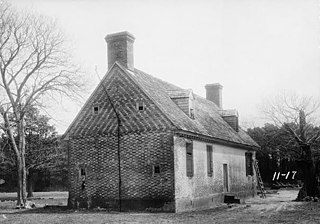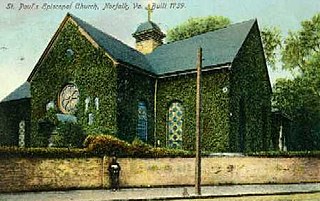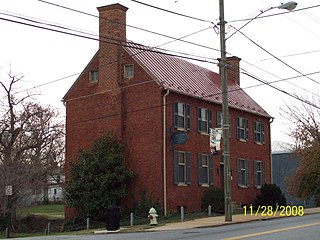
Berkley was an incorporated town in Norfolk County, Virginia. Chartered by an Act of Assembly in 1890, the Town of Berkley was located directly across the Eastern Branch Elizabeth River from the City of Norfolk in the South Hampton Roads area.

Buildings, sites, districts, and objects in Virginia listed on the National Register of Historic Places:

The Hotel Roanoke & Conference Center is a luxury hotel located in the Gainsboro neighborhood of Roanoke, Virginia. Originally built in 1882, the hotel has been renovated many times. It is currently owned by Virginia Tech and operated under the Curio - A Collection by Hilton brand. It was added to the National Register of Historic Places in 1996.

The Adam Thoroughgood House is a brick house located at 1636 Parish Road, in the neighborhood of Thoroughgood, in Virginia Beach, Virginia, United States. It was built ca. 1719. The building underwent major restorations in 1923 and in the 1950s and has served as a museum since opening to the public April 29, 1957. Much of the current structure was most likely the house of the great-grandson of Adam Thoroughgood. The City of Virginia Beach acquired the property in 2003. A 2004 grant application to the National Park Service resulted in a $150,000 award from the prestigious Save America's Treasures program. The City matched that amount as required. This restoration took longer and cost more than expected, but the house reopened in May 2011.

The Adam Keeling House is a historic house in Virginia Beach, Virginia, United States.

Downtown Norfolk serves as the traditional center of commerce, government, and culture in the Hampton Roads region. Norfolk, Virginia's downtown waterfront shipping and port activities historically played host to numerous and often noxious port and shipping-related uses. With the advent of containerized shipping in the mid-19th century, the shipping uses located on Norfolk's downtown waterfront became obsolete as larger and more modern port facilities opened elsewhere in the region. The vacant piers and cargo warehouses eventually became a blight on downtown and Norfolk's fortunes as a whole. But in the second half of the century, Norfolk had a vibrant retail community in its suburbs; companies like Smith & Welton, High's, Colonial Stores, Goldman's Shoes, Lerner Shops, Hofheimer's, Giant Open Air, Dollar Tree and K & K Toys were regional leaders in their respective fields. Norfolk was also the birthplace of Econo-Travel, now Econo Lodge, one of the nation's first discount motel chains.

Saint Paul's Episcopal Church is a historic church in Norfolk, Virginia, United States. Built in 1739, it is the sole colonial-era building which survived the various wars that Norfolk has witnessed. The church has played host to several different denominations throughout its history. Originally an Anglican church, the building was home to a Baptist parish in the early-19th century and was finally converted back into an Episcopal church.

Sabine Hall is a historic house located near Warsaw in Richmond County, Virginia. Built about 1730, it is one of Virginia's finest Georgian brick manor houses. It was built by noted planter Landon Carter (1710–1778). It was added to the National Register of Historic Places in 1969, and declared a National Historic Landmark in 1970.

Clark Hall is a building on the campus of the University of Virginia in Charlottesville, Virginia. It was completed in 1932 to hold the university's School of Law. Its two-story, sky-lit, mural-decorated Memorial Library room "is one of the Commonwealth's most significant 20th-century architectural interiors". The building was listed on the National Register of Historic Places on September 5, 2008.

The Kentucky Hotel is a historic hotel building located at Lynchburg, Virginia. It is one of Lynchburg's three remaining early 19th century ordinaries. It was probably built before 1800, and is a 2 1⁄2-story structure of brick laid in Flemish bond. In about 1814, two side bays were completed, converting the house to a center hall plan.

The South River Friends Meetinghouse, or Quaker Meeting House, is a historic Friends meeting house located at Lynchburg, Virginia. It was completed in 1798. It is a rubble stone structure, approximately 30 by 51 feet, with walls 16 inches thick, and 12 feet high. The building ceased as a Quaker meeting house in the 1840s, and stands on the grounds of the Quaker Memorial Presbyterian Church. Adjacent to the structure is a historic graveyard. Buried there are Sarah Lynch and her son John, the founder of the city whose final resting place is marked by a plain Quaker stone and a modern plaque.

Toddsbury is a historic home located on the banks of the North River in Gloucester County, Virginia. The house was built around 1669 by Thomas Todd and inhabited by his descendants until 1880. The house continues to be a private residence.

Yates Tavern, also known as Yancy Cabin, is a historic tavern located near Gretna, Pittsylvania County, Virginia. The building dates to the late-18th or early-19th century, and is a two-story, frame building sheathed in weatherboard. It measures approximately 18 feet by 24 feet and has eight-inch jetty on each long side at the second-floor level. It is representative of a traditional hall-and-parlor Tidewater house. The building was occupied by a tavern in the early-19th century. It was restored in the 1970s.

Fredericksburg Town Hall and Market Square, also known as the Fredericksburg Area Museum and Cultural Center, is a historic town hall and public market space located at Fredericksburg, Virginia. It was built between 1814 and 1816, and consists of a two-story, five bay, rectangular center block with flanking one-story rectangular wings in the Federal style. The brick building has stone steps fanning the front of the structure. The building has large sandstone arches in the back that open to the Market Square. Market Square is a paved area that abuts the rear of the building. The building housed city offices until 1982.

Taylor–Whittle House is a historic home located at Norfolk, Virginia. It was built about 1791, and is a two-story, three-bay, 40 feet square, Federal style brick townhouse. The house has a pedimented gable roof, and a small pedimented roof supported on Doric order columns over the porch. It has a brick and frame rear kitchen ell. There is a two-level Italianate style porch added to the garden side. The Norfolk Historic Foundation took possession of the house in 1972, and house has served as the offices of the Norfolk Historical Society and the Junior League of Norfolk-Virginia Beach until 2011.

Old Norfolk City Hall, also known as the Seaboard Building and U.S. Post Office and Courthouse, is a historic city hall located at Norfolk, Virginia. It was built in 1898-1900, and is a three-story faced with rusticated stone and yellow brick in a Neo-Palladian Revival style. It features a central pedimented engaged portico with Corinthian order pilasters that contains the main entrance. The building housed a post office and Federal courts until they moved to the Walter E. Hoffman United States Courthouse about 1935. Title to the building was transferred from the U.S. government to the city of Norfolk in 1937, when it was converted into a city hall.

The West Freemason Street Area Historic District is a national historic district located at Norfolk, Virginia. It encompasses 48 contributing buildings in a primarily residential section on the western edge of the center city of Norfolk. It developed between the late-18th and early-20th centuries and includes notable examples of the Federal, Greek Revival, and Late Victorian styles. Notable buildings include the Glisson House, Whittle House, McCullough Row, and the Camp-Hubard house. Located in the district is the separately listed Allmand-Archer House.

Petersburg City Hall is a historic city hall building located at Petersburg, Virginia. It was designed by architect Ammi B. Young and built between 1856 and 1859, as the U.S. Customs House and Post Office.

Portsmouth Courthouse, also known as Norfolk County Courthouse, is a historic courthouse building located at Portsmouth, Virginia. It was built in 1846, and is a one-story with basement, Greek Revival style brick building. It measures 78 feet wide by 57 feet deep. The building is topped by a paneled parapet with Doric order entablature supported by plain Greek Doric pilasters. The building remained in use as a courthouse until 1960, when the county government moved to Great Bridge.





























